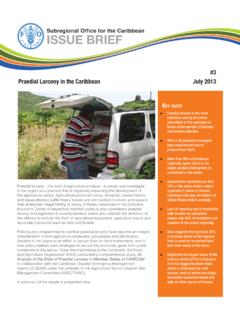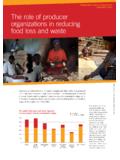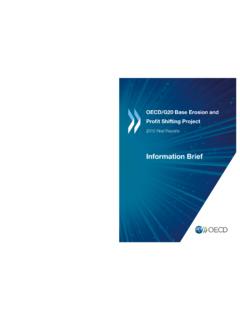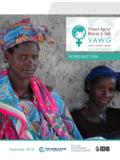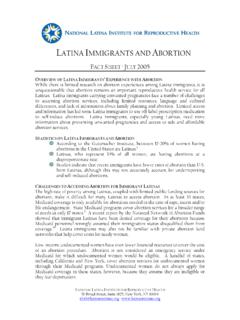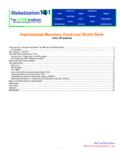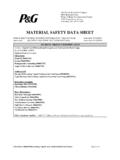Transcription of Coral Reef Resilience and Resistance to Bleaching
1 Coral Reef Resilience and Resistance to Bleaching Gabriel D. Grimsditch and Rodney V. SalmIUCN Resilience Science Group Working Paper Series - No 1 IUCN Global Marine ProgrammeFounded in 1948, The World Conservation Union brings together States, government agencies and a diverse range of non-governmental organizations in a unique world partnership: over 1000 members in all, spread across some 140 countries. As a Union, IUCN seeks to influence, encourage and assist societies throughout the world to conserve the integrity and diversity of nature and to ensure that any use of natural resources is equitable and ecologically IUCN Global Marine Programme provides vital linkages for the Union and its members to all the IUCN activities that deal with marine issues, including projects and initiatives of the Regional offices and the 6 IUCN Commissions.
2 The IUCN Global Marine Programme works on issues such as integrated coastal and marine management, fisheries, marine protected areas, large marine ecosystems, Coral reefs, marine invasives and protection of high and deep seas. The Nature ConservancyThe mission of The Nature Conservancy is to preserve the plants, animals and natural communities that represent the diversity of life on Earth by protecting the lands and waters they need to survive. The Conservancy launched the Global Marine Initiative in 2002 to protect and restore the most resilient examples of ocean and coastal ecosystems in ways that benefit marine life, local communities and economies.
3 The Conservancy operates over 100 marine conservation projects in more than 21 countries and 22 states; we work with partners across seascapes and landscapes through transformative strategies and integrated planning and action. The focus is on: (1) Setting priorities for marine conservation using ecoregional assessments and tools for ecosystem based management; (2) Ensuring Coral reef survival by creating resilient networks of marine protected areas; (3) Restoring and conserving coastal habitats by utilizing innovative new methods; (4) Building support for marine conservation through strategic partnerships and working to shape global and national policies.
4 Marine conservation in The Nature Conservancy builds upon the organization s core strengths: achieving demonstrable results; working with a wide range of partners, including non-traditional partners; science-based, robust conservation planning methodologies; our experience with transactions; and, perhaps most importantly, our ability and commitment to back up our strategies with human, financial and political capital. For more information e-mail or go to authors would like to thank Andrew Hurd, Carl Gustaf Lundin, Paul Marshall, David Obura, and Kristin Sherwood for guidance and edits; Elizabeth McLeod for thoughtful comments and useful material and references incorporated into the document; and James Oliver for the design and publication was made possible through the generous support of the MacArthur Foundation ( ).
5 Cover PhotographyFront cover: Large table Coral (Acropora), Komodo National Park, Indonesia. Photo: Rod SalmBack cover: Bleached Coral , Great Barrier Reef, Australia. Photo: Paul Marshall/GBRMPA Coral Reef Resilience and Resistance to BleachingThe designation of geographical entities in this book, and the presentation of the material, do not imply the expression of any opinion whatsoever on the part of The World Conservation Union (IUCN) or The Nature Conservancy concerning the legal status of any country, territory, or area, or of its authorities, or concerning the delimitation of its frontiers or boundaries.
6 The views expressed in this publication do not necessarily reflect those of IUCN or The Nature Conservancy, nor does citing of trade names or commercial processes constitute endorsement. Published by: The World Conservation Union (IUCN), Gland, Switzerland Copyright: 2006 The International Union for the Conservation of Nature and Natural Resources / The Nature Conservancy Reproduction of this publication for educational or other non-commercial purposes is authorized without prior written permission from the copyright holders provided the source is fully acknowledged.
7 Reproduction of this publication for resale or other commercial purposes is prohibited without prior written permission of the copyright holders. Citation: Grimsditch, Gabriel D. and Salm, Rodney V. (2006). Coral Reef Resilience and Resistance to Bleaching . IUCN, Gland, Switzerland. 52pp. ISBN-10: 2-8317-0950-4 ISBN-13: 978-2-8317-0950-5 Available from: IUCN Global Marine Programme, The World Conservation Union (IUCN), Rue Mauverney 28, 1196 Gland, Switzerland. Tel: +41 22 999 02 17 Fax: +41 22 999 00 25 E-mail: This publication is available as a download from the IUCN Global Marine Programme website at the following address: A catalogue of IUCN publications is also available.
8 Printed in Switzerland on chlorine- free paper from FSC-certified forests. Coral Reef Resilience and Resistance to BleachingGabriel D. Grimsditch and Rodney V. SalmIUCN Resilience Science Group Working Paper Series - No 1 ForewordForewordVast changes in the seas are destroying the world s precious Coral reefs at an unprecedented rate and scale. Burgeoning populations, destructive fishing practices, coastal development, sedimentation from forest clearing and unsound agricultural practices, expanding tourism, and increasing pollution are the primary agents of human impact.
9 And, over the past decades, managers have largely focused on abating these critical proximate threats to Coral reefs. During the past 15 years, however, we have witnessed a major new threat to Coral reefs the threat of Coral Bleaching linked to global warming. Scientists, managers, and all those with a stake in Coral reef survival are challenged to understand this new threat and management actions needed to promote Coral survival. And while we are still at the early stages of understanding and responding to the Coral Bleaching threat, there is much that is being learned.
10 Both IUCN and The Nature Conservancy are committed to providing the marine conservation and management community with information they can use as they carry out in-the-water conservation that recognizes and enhances a reef s natural Resistance and Resilience . It is our intention that this publication will help inform the people responsible for reef management, as well as the broader public, of the current state of knowledge. We would like to thank the MacArthur Foundation for their grant to help establish a Coral Reef Resilience Group to further explore the evolving management options and to put them into Hale Director, Global Marine Initiative The Nature ConservancyCarl Gustaf Lundin Head, IUCN Global Marine Programme(iv)
